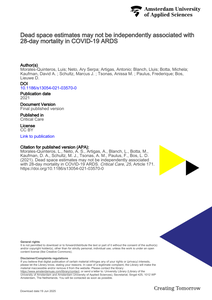BACKGROUND: The SpO2/FiO2 is a useful oxygenation parameter with prognostic capacity in patients with ARDS. We investigated the prognostic capacity of SpO2/FiO2 for mortality in patients with ARDS due to COVID-19.METHODS: This was a post-hoc analysis of a national multicenter cohort study in invasively ventilated patients with ARDS due to COVID-19. The primary endpoint was 28-day mortality.RESULTS: In 869 invasively ventilated patients, 28-day mortality was 30.1%. The SpO2/FiO2 on day 1 had no prognostic value. The SpO2/FiO2 on day 2 and day 3 had prognostic capacity for death, with the best cut-offs being 179 and 199, respectively. Both SpO2/FiO2 on day 2 (OR, 0.66 [95%-CI 0.46-0.96]) and on day 3 (OR, 0.70 [95%-CI 0.51-0.96]) were associated with 28-day mortality in a model corrected for age, pH, lactate levels and kidney dysfunction (AUROC 0.78 [0.76-0.79]). The measured PaO2/FiO2 and the PaO2/FiO2 calculated from SpO2/FiO2 were strongly correlated (Spearman's r = 0.79).CONCLUSIONS: In this cohort of patients with ARDS due to COVID-19, the SpO2/FiO2 on day 2 and day 3 are independently associated with and have prognostic capacity for 28-day mortality. The SpO2/FiO2 is a useful metric for risk stratification in invasively ventilated COVID-19 patients.
MULTIFILE

BACKGROUND: Estimates for dead space ventilation have been shown to be independently associated with an increased risk of mortality in the acute respiratory distress syndrome and small case series of COVID-19-related ARDS.METHODS: Secondary analysis from the PRoVENT-COVID study. The PRoVENT-COVID is a national, multicenter, retrospective observational study done at 22 intensive care units in the Netherlands. Consecutive patients aged at least 18 years were eligible for participation if they had received invasive ventilation for COVID-19 at a participating ICU during the first month of the national outbreak in the Netherlands. The aim was to quantify the dynamics and determine the prognostic value of surrogate markers of wasted ventilation in patients with COVID-19-related ARDS.RESULTS: A total of 927 consecutive patients admitted with COVID-19-related ARDS were included in this study. Estimations of wasted ventilation such as the estimated dead space fraction (by Harris-Benedict and direct method) and ventilatory ratio were significantly higher in non-survivors than survivors at baseline and during the following days of mechanical ventilation (p < 0.001). The end-tidal-to-arterial PCO2 ratio was lower in non-survivors than in survivors (p < 0.001). As ARDS severity increased, mortality increased with successive tertiles of dead space fraction by Harris-Benedict and by direct estimation, and with an increase in the VR. The same trend was observed with decreased levels in the tertiles for the end-tidal-to-arterial PCO2 ratio. After adjustment for a base risk model that included chronic comorbidities and ventilation- and oxygenation-parameters, none of the dead space estimates measured at the start of ventilation or the following days were significantly associated with 28-day mortality.CONCLUSIONS: There is significant impairment of ventilation in the early course of COVID-19-related ARDS but quantification of this impairment does not add prognostic information when added to a baseline risk model.TRIAL REGISTRATION: ISRCTN04346342. Registered 15 April 2020. Retrospectively registered.
MULTIFILE

It is important for caregivers and patients to know which wounds are at risk of prolonged wound healing to enable timely communication and treatment. Available prognostic models predict wound healing in chronic ulcers, but not in acute wounds, that is, originating after trauma or surgery. We developed a model to detect which factors can predict (prolonged) healing of complex acute wounds in patients treated in a large wound expertise centre (WEC). Using Cox and linear regression analyses, we determined which patient- and wound-related characteristics best predict time to complete wound healing and derived a prediction formula to estimate how long this may take. We selected 563 patients with acute wounds, documented in the WEC registry between 2007 and 2012. Wounds had existed for a median of 19 days (range 6-46 days). The majority of these were located on the leg (52%). Five significant independent predictors of prolonged wound healing were identified: wound location on the trunk [hazard ratio (HR) 0·565, 95% confidence interval (CI) 0·405-0·788; P = 0·001], wound infection (HR 0·728, 95% CI 0·534-0·991; P = 0·044), wound size (HR 0·993, 95% CI 0·988-0·997; P = 0·001), wound duration (HR 0·998, 95% CI 0·996-0·999; P = 0·005) and patient's age (HR 1·009, 95% CI 1·001-1·018; P = 0·020), but not diabetes. Awareness of the five factors predicting the healing of complex acute wounds, particularly wound infection and location on the trunk, may help caregivers to predict wound healing time and to detect, refer and focus on patients who need additional attention.
DOCUMENT
